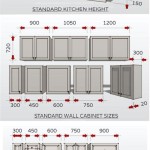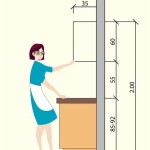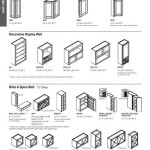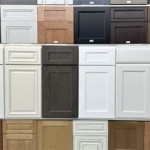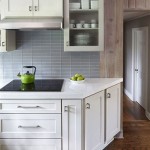Flat Front Kitchen Cabinets: A Sleek and Modern Design Choice
Flat front kitchen cabinets, also known as slab cabinets, represent a distinct departure from traditional cabinet designs characterized by raised panels, ornate moldings, and visible frames. These cabinets feature a simple, unadorned door or drawer front, creating a clean, minimalist aesthetic. Their popularity has surged in recent years, driven by the increasing demand for contemporary and modern interior design schemes. This article explores the various facets of flat front kitchen cabinets, covering their design characteristics, material options, advantages, disadvantages, style considerations, installation nuances, and maintenance requirements.
The essence of flat front cabinets lies in their streamlined design. The absence of embellishments allows the material itself to take center stage. This creates a visually uncluttered space, which is particularly beneficial in smaller kitchens where maximizing the perception of roominess is paramount. The sleek lines and smooth surfaces contribute to a sense of order and sophistication, aligning with the core principles of modern design.
Key Point 1: Design and Aesthetic Appeal
The primary distinguishing feature of flat front cabinets is their minimalist design. The doors and drawers are typically constructed from a single, flat piece of material, devoid of any raised panels, carvings, or intricate details. This simplicity lends itself well to a variety of design aesthetics, ranging from ultra-modern to Scandinavian and even transitional styles. The clean lines create a backdrop that allows other design elements, such as countertops, backsplashes, and hardware, to become more prominent.
One of the significant advantages of this design is its versatility in terms of color and finish. Flat front cabinets can be painted in a wide array of hues, from vibrant and bold colors to subtle and neutral tones. Popular choices include white, gray, black, and various shades of wood stain. The smooth surface also allows for a seamless application of different finishes, such as matte, gloss, or textured coatings. This flexibility allows homeowners to customize their kitchen to perfectly match their individual preferences and the overall design of their home.
Furthermore, the hardware selection plays a crucial role in the overall aesthetic of flat front cabinets. Minimalist hardware, such as sleek pulls or integrated handles, often complements the clean lines of the cabinets. However, more decorative hardware can also be used to add a touch of personality and visual interest. The key is to choose hardware that is proportional to the size of the cabinets and that aligns with the desired style of the kitchen.
The edging detail of flat front cabinets is another important design consideration. Different edging options, such as square edges, beveled edges, or rounded edges, can subtly alter the overall look of the cabinets. Square edges offer a more contemporary and streamlined appearance, while beveled or rounded edges can soften the design and add a touch of elegance.
Key Point 2: Material Options and Durability
Flat front kitchen cabinets can be constructed from a variety of materials, each with its own unique set of properties, advantages, and disadvantages. The choice of material will influence the durability, cost, and overall aesthetic of the cabinets.
Solid Wood: Solid wood is a classic and durable material for cabinet construction. It offers a natural beauty and warmth that is difficult to replicate with other materials. Popular wood species for flat front cabinets include maple, oak, cherry, and walnut. Solid wood is known for its strength and longevity, but it is also susceptible to warping and cracking in environments with fluctuating temperature and humidity levels. Solid wood cabinets are typically the most expensive option.
Plywood: Plywood is an engineered wood product made by layering thin sheets of wood veneer and bonding them together with adhesive. It is a more stable and affordable alternative to solid wood. Plywood is less prone to warping and cracking and provides a smooth surface for painting or staining. High-quality plywood is durable and can withstand the rigors of daily use in a kitchen environment.
Medium-Density Fiberboard (MDF): MDF is another engineered wood product made from wood fibers that are compressed together with resin. It is a dense and uniform material that is ideal for painting. MDF is less expensive than solid wood and plywood, but it is also more susceptible to moisture damage. While MDF provides a consistently smooth surface for painting, it lacks the natural grain and character of solid wood.
Laminate: Laminate is a synthetic material made from layers of paper or fabric that are saturated with resin and bonded together under high pressure. Laminate cabinets are typically constructed by applying a laminate sheet to a substrate material, such as MDF or particleboard. Laminate is a durable and affordable option that is easy to clean and maintain. It is available in a wide range of colors, patterns, and textures, including wood-grain patterns that mimic the look of real wood. Laminate is resistant to scratches, stains, and moisture, making it a practical choice for busy kitchens.
Thermofoil: Thermofoil is a vinyl material that is heat-sealed onto a substrate material, such as MDF. Thermofoil cabinets offer a smooth, seamless surface that is easy to clean and maintain. They are also available in a variety of colors and finishes, including high-gloss options. However, thermofoil is susceptible to heat damage and can peel or bubble over time if exposed to high temperatures.
The durability of flat front cabinets is also influenced by the quality of the hardware, such as hinges and drawer slides. High-quality hardware will ensure that the cabinets function smoothly and reliably for many years. Soft-close hinges and drawer slides are a popular upgrade that adds a touch of luxury and prevents slamming.
Key Point 3: Installation and Maintenance
The installation of flat front kitchen cabinets is similar to that of other cabinet styles. However, there are a few key considerations to keep in mind to ensure a successful installation.
Proper leveling and alignment are crucial for achieving a professional-looking result. The cabinets must be installed plumb and level to prevent doors and drawers from binding or sticking. Shims can be used to adjust the cabinets as needed. It is also important to ensure that the cabinets are securely fastened to the wall studs to prevent them from shifting or pulling away from the wall.
The selection of the appropriate hardware and fasteners is also important. The hardware should be compatible with the material of the cabinets and the weight of the doors and drawers. High-quality screws and fasteners will ensure that the cabinets are securely attached to the wall and that the hardware functions smoothly.
After installation, regular maintenance is essential to keep flat front kitchen cabinets looking their best. Cleaning the cabinets regularly with a mild detergent and water will remove dirt, grease, and grime. Avoid using abrasive cleaners or scouring pads, as these can damage the finish. For wood cabinets, it is important to periodically apply a wood cleaner and polish to protect the finish and prevent drying and cracking.
Laminate and thermofoil cabinets are relatively easy to clean and maintain. Simply wipe them down with a damp cloth and a mild detergent. Avoid using harsh chemicals or abrasive cleaners, as these can damage the surface. It is also important to protect thermofoil cabinets from excessive heat, as this can cause the vinyl to peel or bubble.
Addressing any minor damage or wear and tear promptly will help to extend the lifespan of flat front kitchen cabinets. Scratches and chips can be repaired with touch-up paint or wood filler. Loose hinges and drawer slides can be tightened or replaced. By taking proper care of flat front cabinets, homeowners can ensure that they remain a beautiful and functional part of their kitchen for many years.
The choice of professional installation versus DIY installation is also a significant factor. While DIY installation can save money, it requires a certain level of skill and experience. Improper installation can lead to a variety of problems, such as uneven cabinets, misaligned doors and drawers, and insecurely fastened cabinets. Hiring a professional installer ensures that the cabinets are installed correctly and that any potential problems are addressed promptly.
In addition to regular cleaning and maintenance, it is important to protect flat front kitchen cabinets from excessive moisture and humidity. Water damage can cause wood cabinets to warp and crack, and it can also damage the finish of laminate and thermofoil cabinets. Proper ventilation in the kitchen will help to prevent moisture buildup. It is also important to wipe up spills promptly and to avoid leaving wet dishes or sponges on the cabinet surfaces.
Ultimately, the decision to choose flat front kitchen cabinets involves weighing their aesthetic appeal, material durability, installation considerations, and maintenance requirements. Their clean lines and modern aesthetic make them a popular choice for contemporary kitchens. With proper selection, installation, and maintenance, flat front cabinets can provide years of beauty and functionality.

Kitchen Cabinet Door Styles Cabinets Of The Desert

53 Flat Panel Kitchen Cabinets With Pros And Cons Digsdigs

Custom Made Flat Panel Walnut Cabinet Doors Estate Millwork

White Flat Front Cabinets Design Ideas

Are Flat Panel Kitchen Cabinets In Style O Hanlon Remodeling

Rta Flat Panel Cabinets Kitchen

Flat Front Kitchen Cabinets Design Ideas

Using Flat Panel Kitchen Cabinets For A Modern Look Block Guides

Kitchen Cabinet Compendium City And Bath

Raised Panel Vs Flat Kitchen Cabinet Doors
Related Posts



